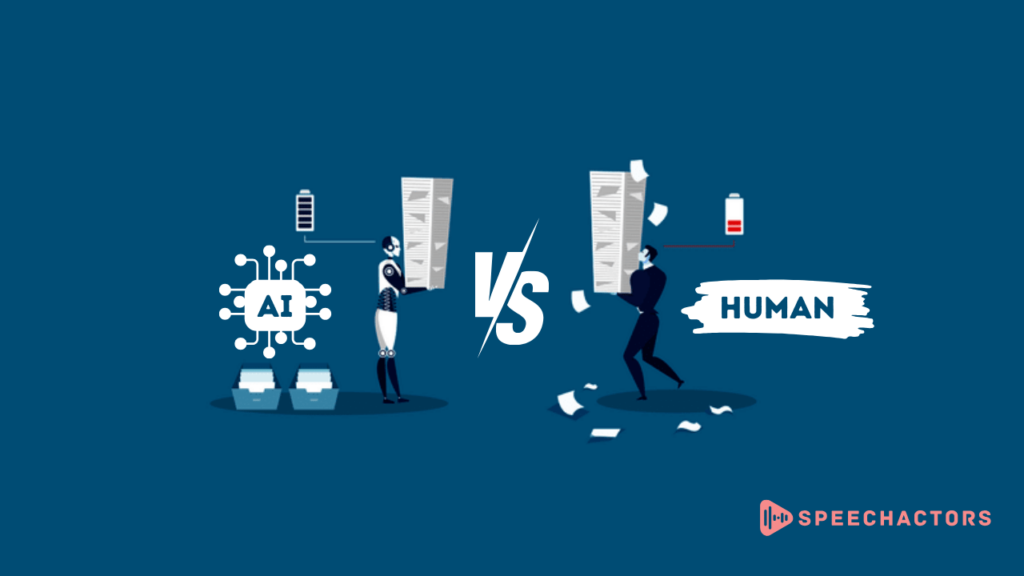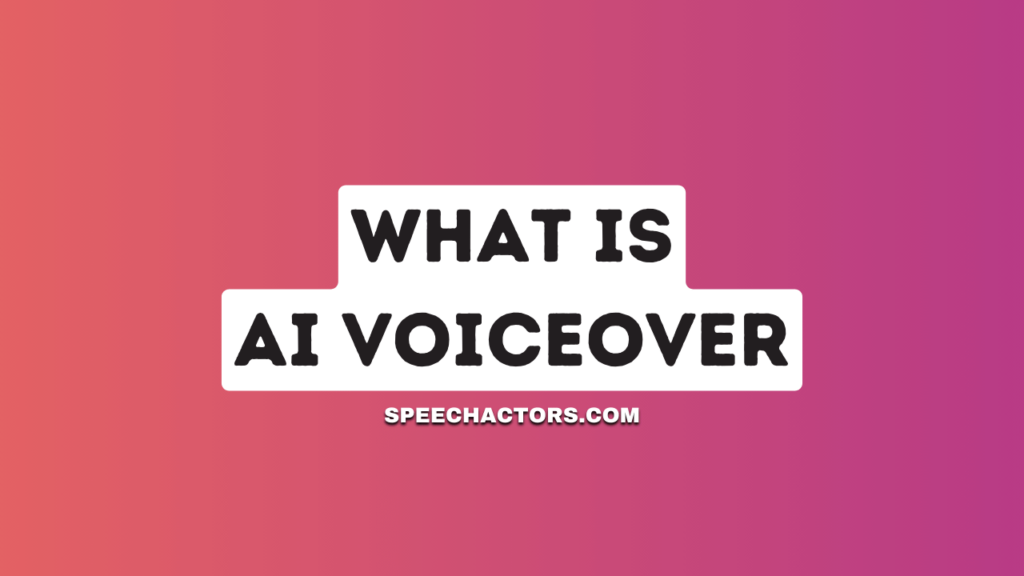AI voice-over is when a computer talks instead of a real person in a video or audio. It’s getting popular because it’s quick and can save money. You hear it in things like YouTube videos, phone systems, and even video games.
In this guide, we’ll talk about what AI voice-over is and where it’s being used. We’ll also look at how it’s different from human voice-over and what the pros and cons are.
By the end, you’ll know why AI voice-over is becoming a big deal and where you might start hearing it more.
What Is AI Voice Over?
AI Voice Over is like a robot reading out loud for you. Instead of hiring a real person to talk in your video or presentation, you use a computer program. This program can read your script in a voice that sounds almost like a human.
It’s a quick way to add talking to your projects. You just type what you want the voice to say, and the program does the rest. It’s good for when you’re in a hurry or don’t have a lot of money to spend on a human voice actor.
How Does AI Voice Over Work?

AI Voice Over works with computer software that’s really smart. It’s trained to talk like a human. When you give it a script or some words, it turns that text into speech.
So, how does it actually work? You type what you want to be said into the program. Then, you pick the type of voice you want like a man’s voice, a woman’s voice, or even a voice with an accent.
Hit the ‘Go’ button, and the program reads it out loud for you. It’s like a robot talking instead of a real person.
Behind The Scene Of How Does AI Voice Over Work?
AI stands for Artificial Intelligence. It’s a kind of technology that mimics human abilities. In this case, it mimics the human voice. The technology uses something called algorithms, which are like sets of rules for how to do something.
These algorithms analyze tons of recorded human voices to learn the patterns and tones. Once the AI has learned from these voice samples, it can generate its own speech. This is done through a process known as text-to-speech (TTS).
You input the text you want to be converted into spoken words, and the AI processes it according to the rules it has learned. Then, it outputs speech that sounds quite similar to a human voice. This is great for many reasons.
It’s fast and efficient, saving you time. It can also be much cheaper than hiring a professional voice actor, especially for long or complex scripts. Because the AI can generate speech in real-time, you can even interact with it, making it useful for things like customer service bots or interactive applications.
What Are The Benefits Of AI Voiceover?

AI Voiceover has a lot of benefits. First up, it’s super fast. You type what you want, and boom, you have your voiceover in seconds. No waiting around for a real person to record it.
Next, it’s cheaper than hiring a voice actor. If you’re on a tight budget, this is a win. Plus, you can pick from a bunch of different voices, accents, and styles. It’s like having a whole team of voice actors at your fingertips.
Also, it’s great for last-minute changes. Need to tweak a word or a sentence? Easy peasy. Just edit the text and get a new voiceover in no time.
Last but not least, it’s really versatile. You can use AI Voiceover for a bunch of things like videos, podcasts, or even phone systems. It’s super handy for lots of different projects.
Types of AI voices
AI voices come in a bunch of different types.
Text-to-Speech
First, you’ve got the “Text-to-Speech” voices. These are the simplest and read out whatever text you type in. They’re used a lot for reading articles or helping people with visual impairments.
Conversational
“Conversational” AI voices. are smarter and can chat with you like a real person. They’re used in things like customer service chatbots or virtual assistants like Siri or Alexa.
Emotional
“Emotional” AI voices. These are pretty advanced. They can express feelings like happiness, sadness, or excitement. These are great for storytelling or more engaging content.
Specialized
Lastly, there are “Specialized” AI voices. These are trained for specific industries like healthcare or law. They know all the jargon and can understand complex terms, making them super useful for certain jobs.
So, there’s a lot to choose from depending on what you need. Whether it’s reading a script or having a full-on chat, there’s an AI voice for that.
AI vs. Human Voice Over Difference

AI Voice Over:
AI voice over is quick and often cheaper. You type in what you want it to say, and the machine spits it out. It’s super useful when you have to produce a lot of content and don’t have much time.
But the downside? Even though it’s getting better, it’s not always as natural or emotive as a human voice. It might lack the personal touch that a human can offer.
Human Voice Over:
Human voice over is more nuanced. A real person can add emotion, change tone, or pause in a way that feels natural. This is great for projects that need a personal touch like storytelling or brand ads.
The downside? It can be more expensive and time-consuming, especially if you’re hiring a professional.
Both have their pros and cons, so the right choice depends on what you need. Quick and easy? Go with AI. Looking for emotional depth? A human’s probably your best bet.
Pros and Cons of Ai vs Human Voice Over
Sure, here’s a quick table outlining the pros and cons of AI vs Human VoiceOver:
| Criteria | AI VoiceOver | Human VoiceOver |
| Cost | Usually cheaper | Often more expensive |
| Speed | Fast, almost instant | Takes time, scheduling |
| Emotional Nuance | Limited | High |
| Customization | Basic tone control | Highly customizable |
| Consistency | Very consistent | Can vary |
| Updates | Easy to edit | Might need re-recording |
| Authenticity | Often lacks | More authentic |
| Languages | Multiple languages easy | Dependent on talent |
| Availability | 24/7 | Limited availability |
| Unique Style | Usually not | Yes, unique voice |
How realistic are AI voice-overs?
AI voice-overs have come a long way in sounding more natural and human-like. With advances in machine learning and text-to-speech technology, they can mimic human speech patterns pretty closely. You can often choose different tones, accents, and even emotions to some extent.
However, they still have limitations. They might not capture the full range of human emotions or the subtle nuances that a human voice can provide.
Sometimes you can tell it’s a machine because the voice lacks the warmth or complexity that comes naturally to humans. So, while they’re getting better and more realistic, they’re not 100% there yet.
If you want to get more indepth idea on voice over then you can check out our beginners guide for voice over.
FAQs
Is AI VoiceOver the same as Text-to-Speech?
They’re similar but not the same. AI VoiceOver generally has more natural-sounding voices and intonations, thanks to machine learning algorithms.
Can AI VoiceOver understand emotions and context?
Advanced AI VoiceOver systems can analyze text for context and tone, thus providing a more expressive and natural-sounding voice output.
Can I customize the voice in AI VoiceOver?
Yes, many platforms allow you to choose from different voice types, accents, and even languages.
Is AI Voice Over good for accessibility?
Absolutely, it’s widely used to make content more accessible to those with reading or vision difficulties.
Conclusion
AI VoiceOver is a technology that uses artificial intelligence to turn text into spoken words. This can be incredibly helpful for a variety of reasons, like making content more accessible or multitasking more manageable.
You might find yourself considering AI VoiceOver for your own use. Whether for work, education, or personal convenience, it’s a useful tool to have at your disposal. Give it a try and see how it can benefit you!
